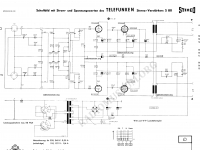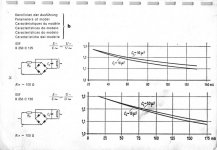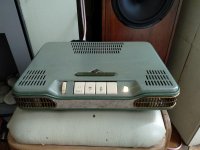Hi All, hoping someone with a better knowledge of valve amp circuits can help me out with a hum issue, I have always liked the look of these vintage telefunken amplifiers and finally got a cheap one from Germany via eBay, I replaced all the caps including some Panasonic low esr high ripple electrolytic caps for power filtering, 2 new ecl82 valves, all the resistors were checked and all within spec. I fitted some 1uf Russian pio caps in place of the original coupling caps as read this helps make it a full range amp as was originally made just for tweeters, It sounds really good and I'm loving it as much as my 300b tubelab se I made earlier this year, it's drives my interdyne bt1 speakers beautifully. Only problem is it has a hum that's heard with volume turned right down and does not change when volume turned up or down, I have attached the schematic I managed to find and would be very grateful for any help!
Many thanks in advance
Phill
Many thanks in advance
Phill
Attachments
1µF coupling cap for this kind of phonograph amplifier is too excessive, the entire set is not designed for such a low (bass) frequency response. Use .1µ or at maximum, 0.22µF. 400VWV is sufficient.(excessive bass response in the amplifier chain will saturate the output transformer with risk of arcing inside it, the ECL82 pentode or the socket among audio distortion).
How much hum?
Is it the same amount on the left and right channels?
If it is 50 Hz and not 100 Hz it may be from magnetic coupling from the power transformer to the output transformer(s).
A steel chassis can cause this.
And close proximity of power and output transformers can cause this.
With an aluminum chassis, the spacing of the power transformer and output transformers is important, and the orientation of the transformer coils is important.
You need the power transformer coils to be at right angles to the output transformers coils.
If the hum is present as soon as the amp is turned on, before the tubes are warmed up, magnetic coupling is the probable cause.
As the tubes warm up, and the negative feedback will then be working, the hum would then be a little lower than it was when the tubes were cold.
If the above is not the cause, and the hum is 50Hz, it sounds like electrostatic coupling of wires to one of the control grid circuits (like secondary high voltage wires, primary wires, or even secondary filament wires (like un-twisted wires to the filaments).
Or, if there is leakage from the filaments to the input triode's cathode, it could develop a voltage across the 150 Ohm feedback resistor that goes from the bottom of the 2.2k and bypass cap; the other end of the 150 Ohm to ground.
If one channel has more hum than the other, power down, swap the tubes from channel to channel. If the hum follows, the filament to cathode is probably leaky.
Is it the same amount on the left and right channels?
If it is 50 Hz and not 100 Hz it may be from magnetic coupling from the power transformer to the output transformer(s).
A steel chassis can cause this.
And close proximity of power and output transformers can cause this.
With an aluminum chassis, the spacing of the power transformer and output transformers is important, and the orientation of the transformer coils is important.
You need the power transformer coils to be at right angles to the output transformers coils.
If the hum is present as soon as the amp is turned on, before the tubes are warmed up, magnetic coupling is the probable cause.
As the tubes warm up, and the negative feedback will then be working, the hum would then be a little lower than it was when the tubes were cold.
If the above is not the cause, and the hum is 50Hz, it sounds like electrostatic coupling of wires to one of the control grid circuits (like secondary high voltage wires, primary wires, or even secondary filament wires (like un-twisted wires to the filaments).
Or, if there is leakage from the filaments to the input triode's cathode, it could develop a voltage across the 150 Ohm feedback resistor that goes from the bottom of the 2.2k and bypass cap; the other end of the 150 Ohm to ground.
If one channel has more hum than the other, power down, swap the tubes from channel to channel. If the hum follows, the filament to cathode is probably leaky.
If the hum issue was already present when you received this amplifier it's quite possible they have it all, like tuberadios from the same era. A simple check to see if it's PS related (100Hz) is to short the triode grid to ground. If you replaced the PS caps with low ESR units there might be an issue with available load current. A simple check could be to solder a 2,2 to 4,7 ohm resistor in series with the reservoir capacitor.
Some hum on S80 / S81 /s82 "weight scale" Telefunken is from factory. Wiring placement and filter capacitor size weren't meant to remove the hum completely, because this was a non-HiFi device meant to be paired with a tube radio, and it was priced accordingly. Today price is higher that the original price (inflaction adjusted), because this device is highly collectable due to the unconventional shape and size. It should be possible to reduce the hum by rearranging the wiring and reworking the power supply: as example, keep the white B+ wire from output trasformer further away from the coupling capacitor; use a physically smaller foil capacitor or shield it; replace the selenium rectifier with a silicon rectifier and add a RC filter cell. I would rather keep the amplifier schematic factory, and enjoy it for what it is.
Some hum on S80 / S81 /s82 "weight scale" Telefunken is from factory. Wiring placement and filter capacitor size weren't meant to remove the hum completely, because this was a non-HiFi device meant to be paired with a tube radio, and it was priced accordingly. Today price is higher that the original price (inflaction adjusted), because this device is highly collectable due to the unconventional shape and size. It should be possible to reduce the hum by rearranging the wiring and reworking the power supply: as example, keep the white B+ wire from output trasformer further away from the coupling capacitor; use a physically smaller foil capacitor or shield it; replace the selenium rectifier with a silicon rectifier and add a RC filter cell. I would rather keep the amplifier schematic factory, and enjoy it for what it is.
I think this is possibly the answer I'm looking for, will try a silicon rectifier and rearranging the b+ wire, I have already ordered some replacement coupling caps which are pio and foil wrapped, isn't there a rc filter already built into this circuit? Shown on the schematic as the smoothing caps with the 270ohm resistor between them or will it require something else?
Many thanks again for all your help, I know it would be nice to keep it original but I would use it a lot more if I could get rid of the hum!
I don't have direct experience on the S80, but it does have a strong resemblance to early German "midrange" FM stereo tube radios. They often have insufficient B+ filtering because they use the same power supply style and capacitor values of mono radios; a further hum source is the bundling of power supply and signal wires to speed up the manufacturing. I believe that the AEG cylindrical selenium rectifier, very common on Telefunken devices built at the end of the '50, has become unreliable now. I have seen a few of them fail shorted; due to the lack of a fuse on the secundary winding of the power transformer, this short burned the transformer. When you replace a selenium rectifier with a modern one, the B+ will increase. It is therefore possible to add a further capacitor and dropping resistor to have a CRCRC power supply configuration instead of the original CRC, keeping the same output voltage value of the original circuit. Due to the bigger power capability of the silicon rectifier, che C in the middle filter cell can be increased to 100uF or more, reducing the hum even further. You may also check the wire placement and try to keep the AC filament supply and the unfiltered B+ wires as far as possible from the low signal wires and components. The complex and high impedence resistor/capacitor network between the inputs and the volume potentiometer may eventually be simplified according to your needs. You may, for instance, connect the input directly to the volume potentiometer. Finally, the wires on the primary of the power transformer should be kept separate from the others and the earth connection added.
Spent sometime and rerouted the b+ wire and also twisted it with the negative wire to the first smoothing cap, also noticed that the main earth coming in is soldered to a plate which is attached to the casing so have used that as a star ground point and rerouted all the ground wires to that plate, I replaced the 1uf coupling caps with some old .1uf caps that I had layered nag about and gave it a test, the hum is now nearly gone, you can just about hear it, hopefully when I replaced the rectifier and fit the 100uf cap and resistor to the filter circuit I can get it silent! one question though, what size resistor should I use or shall I just try different sizes until I get the correct supply voltage?
Many thanks for the help, I really feel I would never have got this far on my own, a real learning experience for me!
Many thanks for the help, I really feel I would never have got this far on my own, a real learning experience for me!
Something between 100 and 330 ohm could be a good starting point, then measure the voltage and use the Ohms law to get the optimal value as you stated. I attach the datasheet of the original selenium rectifier (from Siemens Pocketbook 1958-59).
Many thanks again.
Finally got it nearly silent, after fitting a new rectifier along with the 100uf capacitor and creating a crcrc filter I was still getting hum, tracked it down to the heater ac supply, I had a search and came across info on ac supplies for tube heaters, it said that a ac heater supply needs a centre tap and as this does not have one it gave info on creating an artificial centre tap with a humdinger which is a 500ohm variable resistor across each supply from the transformer with the wiper connected to ground. This I installed and then adjusted to the minimum hum from each speaker, I'm now so happy with this little amp, it sounds amazing, time to start tube rolling!
Many thanks to you all, couldn't have done it with out you!
Cheers
Phill
Many thanks to you all, couldn't have done it with out you!
Cheers
Phill
Ooh! I'll have to give it a try, not much room inside but will see what I can do!Congrats to your solution!
I've made the experience that SE amplifiers like your's always will present some hum. This could be reduced further, or even be eliminated, by replacing the PSU smoothing resistor by a suitable choke or by a SS regulator.
Best regards!
Many thanks
Phill
I design and build SE amplifiers that have 100uV or less hum at the speaker output (using an 8 Ohm load resistor). Speakers have irregular impedance, and hum frequencies are one area where it often varies widely.
All this even without negative feedback, but instead with attention to detail:
Good B+ filtering with CLCRCRC; Aluminum Chassis; proper orientation of output transformers versus the choke and power transformer; reduction of B+ ground loops; reduction of input connector ground loops; etc.
Hmmm?
No, no hum.
You say you are getting hum, the question is, how much?
All this even without negative feedback, but instead with attention to detail:
Good B+ filtering with CLCRCRC; Aluminum Chassis; proper orientation of output transformers versus the choke and power transformer; reduction of B+ ground loops; reduction of input connector ground loops; etc.
Hmmm?
No, no hum.
You say you are getting hum, the question is, how much?
Last edited:
Hum is minimal now, I really have to listen hard to hear it, here is a photo of the amp, I could remove everything and place in a Aluminium chassis but I look be the look of it, the transformers are properly orientated and the only thing ok could now do is fit a choke but there is no room inside for one, I'm very happy with the way it isI design and build SE amplifiers that have 100uV or less hum at the speaker output (using an 8 Ohm load resistor). Speakers have irregular impedance, and hum frequencies are one area where it often varies widely.
All this even without negative feedback, but instead with attention to detail:
Good B+ filtering with CLCRCRC; Aluminum Chassis; proper orientation of output transformers versus the choke and power transformer; reduction of B+ ground loops; reduction of input connector ground loops; etc.
Hmmm?
No, no hum.
You say you are getting hum, the question is, how much?
Attachments
- Status
- This old topic is closed. If you want to reopen this topic, contact a moderator using the "Report Post" button.
- Home
- Amplifiers
- Tubes / Valves
- Telefunken s80 hum



 !
!